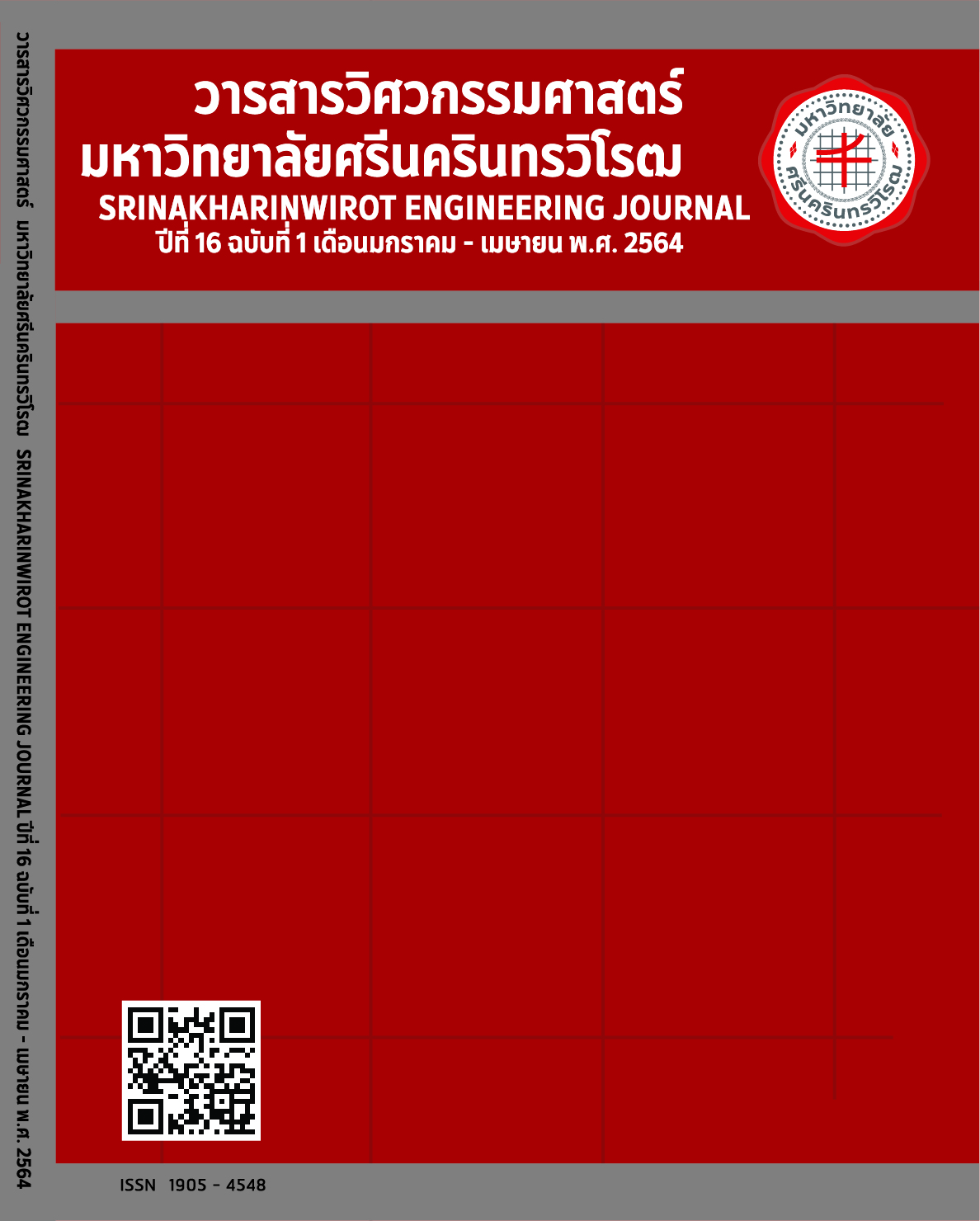Development and Testing of Lotus Seeds Peeling Machine
Main Article Content
Abstract
Growing lotus has been promoted in Thailand particularly in flooded areas where other plants cannot be grown. Lotus seeds can be processed as OTOP product of the provinces with lotus planting areas. This research attempted to design and fabricate a prototype lotus seed shell peeling machine to minimize the time and labor requirement in the fresh lotus seed shell removal. This prototype peeler consists of the main frame, cutting blade unit, Scotch Yoke mechanism, the power transmission unit and a prime mover by 90w-gear-motor. The operation started with manually feeding lotus seeds into chute at the top of machine. Then they were conveyed to blade unit to cut lotus peel in diametrical axis by Scotch Yoke mechanism, and finally seeds were released through outlet chute at the bottom. The results revealed that the average speed of blade 7 m/min worked well among the average speed of blades 6, 7 and 8 m/min respectively. The peeling percentage was 79% without any seed damage with working capacity of 3.6 kg/hr consuming 0.06 kW-hr of energy. An engineering economic analysis showed that it cost an average of THB 12.2 per kilogram at 1,440 hours per year with 3.4-month payback and 102.4 hours per year for break-even point. This prototype can work at least twice as fast as human labor.
Article Details

This work is licensed under a Creative Commons Attribution-NonCommercial-NoDerivatives 4.0 International License.
Copyright belongs to Srinakharinwirot University Engineering Journal
References
W. Suksawat. (2018, April 23). 7 benefits of Thai grains [Online]. Available: http://www.tnews.co.th/contents
R. S. Jolly. (2019, January 25). Benefits of the lotus plant [Online]. Available: https://caloriebee.com/nutrition/Health-Benefits-of-Lotus-Roots-or-Stem-Seeds-Leaves-and-Flowers
K.R. Sridhar and R. Bhat, “Lotus A potential nutraceutical source,” Journal of Agricultural Technology, vol. 3, no. 1, pp. 143-55, 2007.
S. Rai, A. Wahile, K. Mukherjee, B. P. Saha, P. K. Mukherjee, “Antioxidant activity of Nelumbo nucifera (sacred lotus) seeds,” Journal of Ethnopharmacology, pp.104:3227, 2006.
YB. Wu, LJ. Zheng, J. Yi, JG. Wu, CJ. Tan and TQ. Chen, “A comparative study on antioxidant activity of ten different parts of Nelumbo nucifera Gaertn,” Afr.J. Pharm. Pharmacol, vol. 5,pp. 2454–246, 2011.
ZQ. Ling, BJ. Xie and EL. Yang “Isolation characterization and determination of antioxidative activity of oligomeric procyanidins from the seedpod of Nelumbonucifera Gaertn,” J Agric Food Chem, vol. 53, no. 7, pp. 2441-5, 2005.
Department of Agriculture Extension. (2017, May 16). Lotus production situation [Online]. Available: http://www.doae.go.th/LIBRARY
T. Suwannaro, Lotus farming. Extension and Training Office. Bangkok: Kasetsart University, 2007.
P. Vijitwittayapong. (2013, Feb 13). Lotus seeds product of Phichit [Online]. Available: http://www.matichon.co.th/matichon/view_news
J. Langkapin, S. Parnsakhorn, R. Kalsirisilp, M. Prorod, and N. Khotpromsrt, “Study and testing of a lotus seed peeling machine,” Journal of Engineering RMUTT, vol.1, pp.35-42, 2018.
J. Langkapin, S. Parnsakhorn, R. Kalsirisilp, G. Samseemoung, P. Ngmanil, and T. Juey, “Design and fabrication of a lotus seed membrane peeling machine,” Journal of Engineering RMUTT, vol.1,pp. 127-137. 2019.
G. Krutz, L. Thomson and P. Claar, Design of agricultural machinery. 1st ed. New York: John Wiley and Sons, 1994.
JE. Shigley, and CR. Mischke, Mechanical engineering design. 5th ed. USA: McGraw-Hill Book Company, 1989.
J. Langkapin, Engineering Drawing and Design by Solidworks. 3nd ed. Bangkok: Triple Education Co., Ltd, 2018. (in Thai)
D. Hunt, Farm power and machinery. 10th ed. Iowa, USA: Iowa State University Press, 2001.


